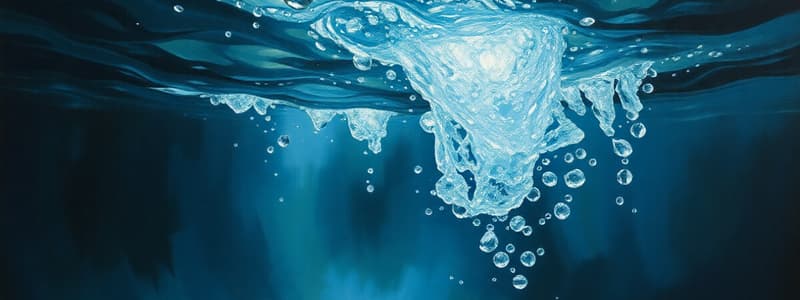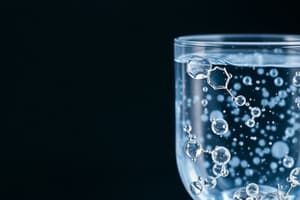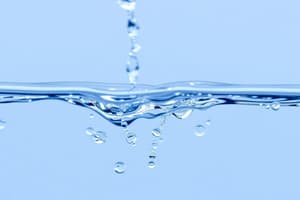Podcast
Questions and Answers
What is the main reason water has a high specific heat?
What is the main reason water has a high specific heat?
- The density of water decreases when heated.
- Water molecules have strong ionic bonds.
- Water must absorb or release a large amount of energy to change temperature. (correct)
- Water is non-polar and does not easily change temperature.
Which property of water allows water striders to walk on the surface?
Which property of water allows water striders to walk on the surface?
- Low density of ice
- High viscosity
- Surface tension from cohesion (correct)
- Universal solvent capabilities
What does the pH value indicate about a solution?
What does the pH value indicate about a solution?
- It represents the total concentration of both hydrogen and hydroxide ions.
- It is inversely related to the concentration of hydronium ions. (correct)
- A lower pH indicates a higher presence of alkaline substances.
- It is directly proportional to the concentration of acids.
What phenomenon is demonstrated by the adhesion of water molecules to polar substances?
What phenomenon is demonstrated by the adhesion of water molecules to polar substances?
Why does ice float in water?
Why does ice float in water?
Flashcards
Polarity of Water
Polarity of Water
Water molecules have a slightly positive end (hydrogen) and a slightly negative end (oxygen), creating polar covalent bonds within water molecules and hydrogen bonds between them.
Cohesion/Adhesion
Cohesion/Adhesion
Cohesion is water's attraction to other water molecules. Adhesion is water's attraction to other polar substances. Together, they create capillary action.
Water as a Solvent
Water as a Solvent
Water dissolves many substances because its polarity allows it to surround and dissolve ions and polar molecules.
Surface Tension of Water
Surface Tension of Water
Signup and view all the flashcards
Density of Ice
Density of Ice
Signup and view all the flashcards
Study Notes
Polarity of Water
- Polar covalent bonds exist between oxygen and hydrogen in a water molecule
- Hydrogen bonds form between the oxygen of one water molecule and the hydrogen of another water molecule
Cohesion/Adhesion
- Cohesion: Water molecules are attracted to other water molecules.
- Adhesion: Water molecules are attracted to other polar substances.
- Together, cohesion and adhesion lead to capillary action.
Universal Solvent
- Partial negative oxygen in water binds to positive ends of other polar molecules.
- Polar water molecules bind to positive and negative ions.
Surface Tension
- Cohesion creates a "surface" due to hydrogen bond interactions.
- Allows for water striders to walk on water.
Less Dense as a Solid
- Hydrogen bonds restrict compaction of ice.
- Ice floats, acting as a temperature buffer.
High Specific Heat
- Water requires a large amount of energy to change its temperature by 1°C.
- This acts as a temperature buffer for organisms.
Evaporative Cooling
- Water released on the surface of an organism absorbs heat energy to break hydrogen bonds, cooling the organism.
pH
- pH = -log[H+]
- As the concentration of hydrogen ions increases, pH decreases.
Studying That Suits You
Use AI to generate personalized quizzes and flashcards to suit your learning preferences.




